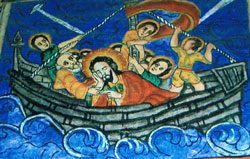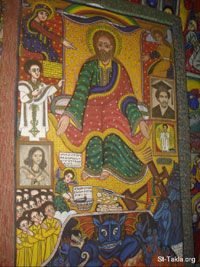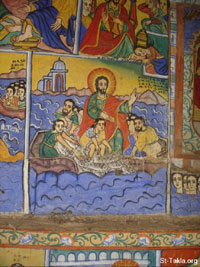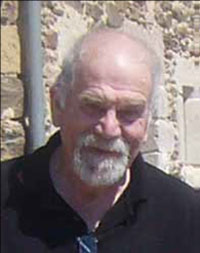Looking at Icons in Ethiopia
by John Clawson
For a long time I had thought on and off about visiting Ethiopia to see the “Coptic” icons and when my friend’s son was transferred to Addis Ababa to work it seemed too good an opportunity to miss so, at the end of October a few years ago , Peter Gilliam, BAI librarian, and myself flew to Addis Ababa Bole airport via Amsterdam. In Addis we spent time visiting the church of St Gabriel and the exhibition of icons at the Addis Ababa museum and also met the Ethiopian Government Director of Conservation and Restoration who is an Icon painter himself. We used the couple of days we were in Addis to acquaint ourselves with the history of the area, to plan our route and to book ourselves a Toyota 4X4 land cruiser and driver for the long journey ahead.
The Ethiopian Orthodox church was founded in Axum in the 4th century by King Ezana who converted to Christianity in 340AD however modern Ethiopia is heavily influenced by Judaism. There are many Jewish influences which, along with the presence of an ancient Jewish community in the old province of Gojjam, and nowadays divided between Amhara and Tigray regions suggests a large pre-Christian Judaic influence in Ethiopia. This Jewish community, the Felashas, have had their numbers reduced over the centuries by war and persecution and the couple of thousand that were left were airlifted out to Israel a few years ago. Islam, too, arrived in Ethiopia in its formative years, and it is the dominant group in eastern Ethiopia south of Tigray.
The Oromo people (referred to as the Galla prior to the 20th century) are Ethiopia’s largest linguistic group. They were pagan when they first swept up the Rift Valley into Ethiopia in the 15th century AD but are now predominantly Christian, with imported Catholic and Protestant denominations. The society and culture of Southern Ethiopia are more typically African in nature than those of the north where the people do not even have prominent African features. Apparently the term Ethiopic arose in Ancient Greece and it means burnt-faced and was one of two used to describe the dark- skinned people of sub-Sahara, the other term was Nubian and referred to the almost black-skinned people of the Nile Valley which is what is now Sudan.
The Jewish influence is at the very core of Ethiopian Christianity. Ethiopians believe that the Ark of the Covenant was brought to Axum in the 1st Millennium BC and that it is still there today. Every Ethiopian Orthodox church has at its heart the Holy of Holies, into which is placed the tabot —a replica of the Ark – and no one is allowed to see the tabot nor indeed allowed anywhere inside the Holy of Holies except the priest. The Holy of Holies in the Churches we saw was a circular room with a stone wall built up to the ceiling containing (usually) 3 closed doors and sometimes windows (covered) with each wall beautifully decorated with icon paintings and frescos.
The icons we saw in the museum were arranged in chronological order and were identified by “schools” so we had for example the Axumite icons of the school of the long moustache painters or the Gondarine icons of the school of the richly decorated coats. Another characteristic we noticed was that profiles were painted to indicate someone not well thought of, so we had for example, the Roman soldiers at the crucifixion and the apostle Judas in profile.
The icons and wall paintings at St Gabriel’s were beautiful and we were given at lot of information by the priest at the Church. He also very kindly showed us an old cave church in the grounds near the present church which had been a place of worship for many years during the 14/15th century or even earlier. We were beginning to notice an amazing thing – everyone was pleased to see us and were happy to help and everyone had a large smile on their face ! I was also beginning to notice how difficult it was becoming to breath – we were now living at about 2400 metres above sea level.
However our appetite was truly whetted. We were now impatient to commence our journey. We had decided to travel to Badir Dar, which is on Lake Tana and from there to Gonder and then to Lalibela and then back to Addis by a route we would plan in Lalibela.
We set off on Saturday and travelled through many villages and towns and, with it being Saturday, it was market day and the roads were full of people taking their livestock to market. True to form they all had a big grin on their face and even when we had our frequent punctures the large groups of youths that surrounded us were very pleasant and offered to help and amazingly spoke English. We travelled down into the Rift Valley, across a rickety bridge over the Blue Nile, then up the other side on dirt roads and were generally tossed about ’till we were beginning to feel we had had enough. Then we were there. Lake Tana – the source of the Blue Nile.
Badir Dar is a busy market town on the southern shore of Lake Tana and is home to many monasteries dotted around the islands and peninsular of Lake Tana. We first visited the Ura Kirhane Modret monastery on the Zege peninsular. We went by small boat from Badir Dar and then on foot up to the top of a steep hill. The walk, the height and the constant bombardment of young men smelling of Tej (the local brew) trying to sell souvenirs exacerbated my already difficult breathing and I was glad to get to the monastery. Ura Kirhane Modret is set back within a circle of stone walls and was built in the 16th c. The paintings on the walls of the Holy of Holies really took my breath away. The walls are covered in 16th century paintings depicting scenes from the old and the new testament, scenes of the life and death of saints I knew and saints I had never heard of and scenes from holy books I have also never heard of. For gore and bawdiness they have no rival. There are paintings depicting the seven deaths of St George. Impalement, boiling in tar, chopping up into little pieces – it was amazing. There was a particularly spectacular painting of the devil. There were paintings of the life of Mary from The Miracles of Maryam and there was a painting that really caught my eye, of a one legged saint – St Tekla Haymanot – who mortified himself by standing on one leg in a cell which had spears and sharp pointed sticks pointing at him to prevent him from falling asleep. A bird came to feed him one seed once a year . Anyway after some time his other leg wasted away and dropped off but God came to his aid by rewarding him with a triple set of wings!. There was another saint who I thought was St John the forerunner at first. He was covered in black/brown hair and he is one of the most venerated saints in Ethiopia – Saint Abba Gabra Manfas Qiddus. He was a hermit who founded a monastery near Addis Ababa and who wandered about the desert preaching peace to the wild animals. He once succoured a bird by letting it drink the water from his eye. Another saint depicted on the walls is St Abuna Samuel who is always painted sitting on a lion. We could have spent all day looking at the paintings and listening to the stories our (excellent) guide told us of the paintings however time was moving on and the mosquitoes are worse in the early evening so we set off to our next port of call the Bet Maryam monastery.
Again we were accosted by people selling souvenirs who would not take no for an answer but this monastery was again well worth the visit with many wall paintings and some interesting old drums which are used in worship. We saw gigantic spiders, baboons and eagles on our walk up to the monastery and on our way down succumbed to the souvenir sellers and bought from them though they still wouldn’t leave us alone (this was the only area we were pestered so much). We returned to the boat and sailed past fishermen in 3 small boats made of papyrus (tankwa) as we headed for Kibram Gabriel monastery. This monastery, which is barred to women, houses about 30 monks and is built on a tiny island quite close to Badir Dar. The church was founded in the 13th c and rebuilt in the 17th c. It had (what was now becoming) the usual wall paintings on the walls of the Holy of Holies. We noticed that a lot of restoration was taking place and we mentioned to our guide that we were interested in icon painting. He knew the artist who was restoring the wall paintings and invited us to meet him that evening. The most amazing thing about this monastery however was the library housed in a small wooden shed in the grounds near the church. A library containing almost 200 volumes of ancient books. We were shown many beautifully illustrated books the oldest of which was 13th c —a new testament bible – and the monk in charge cheerfully put the book standing upright on an old stool and invited us to turn the pages. We spent time here just browsing and then returned to Badir Dar.
That evening we visited a newish church on the outskirts of Badir Dar where the artist we met was painting the walls of the Holy of Holies. We spent an interesting time here and enjoyed being in an Ethiopian living church where bible readings were taking place in the grounds with a congregation of about 200 people. The next day we travelled to Gonder on the northern shore of the Lake. It was here that we saw the Fasil Ghebbi (Royal Enclosure), Woleka -the Felasha village and the beautiful church of Debre Birhan Selassie. It was also here that the first signs of tension were starting to manifest on the road outside the university and to the airport. Armed soldiers (Tigrayans) appeared almost overnight and a huge weight came down and covered the city. We spent the best part of a day exploring the Fasil Ghebbi and, interesting as these castles are, I will not spend time here in any description of them.
There are about 40 churches in Gonder and most of these have been rebuilt after the war with the Dervishes or Mandist of Sudan. The only Gonderine church to survive untouched was the Debre Birham Selassie church. Unusually this is a rectangular church although it is said that originally it was almost certainly round in shape. The ceiling is covered in paintings of angels faces with the characteristic huge eyes staring down at you . The wall paintings are painted on cloth and glued to the walls. There are paintings of the life of Christ and scenes from the life of Mary and the Miracles of Mary. There are also paintings of many saints including George, Theodore Fasiladas and Muhammad being led bound on a camel by the devil. The three persons of the holy trinity (all painted to look the same age) are painted over the doors leading to the Holy of Holies. The doors themselves are painted with the Archangels Gabriel and Michael guarding the entrance with their swords. This is truly one of the most beautifully painted churches I have seen. Unfortunately we now started to have problems in travelling. We heard that rioting had broken out in Addis Ababa and that 45 people had been killed with more injured. The situation in Gonder was becoming more and more tense by the hour so we decided to pay the driver off and fly Ethiopian Airways Domestic for the rest of our journey. Suffice to say that because of the troubles our flights didn’t turn up and rioting started in Gonder with 3 deaths and 13 deaths in Badir Dar. After a lot of uncertainty and hanging around in the airport building for 2 days on and off I am happy to say we did eventually manage to get to Lalibela and the whole journey was worth just visiting this small town in northern Ethiopia.
The rock hewn churches of Lalibela are truly one of the wonders of the world. They are BIG – some in excess of lO m high and because they are carved below ground level they are ringed by trenches and courtyards the sides of which are cut into with graves and hermit cells. There are two clusters of churches and the biggest rock hewn church in the world is in the northwest cluster – Bet Medhane Alem – This church is 11.5m high and covers an area of 800 sq m. It is supported by 36 pillars on the inside and another 36 around the outside. All of the churches are connected by tunnels and passageways. The most impressive church is Bet Giorgis which stands 15 metres below the surface in a hewn out courtyard. We managed to visit a monastery before leaving Lalibela – the Nakuta La’ab Monastery which is just outside the town on the way to the airport The church is built around a shallow cave in which several holy pools are fed by natural springs.
We managed to get a flight back to Addis on the same day but there was still unrest in Addis and we weren’t able to get a flight out for 2 days and then only to Nairobi but we did eventually get home much to the relief of our relations! I have not got the space here to recall the many other happenings, the broken wheel hub, Peter’s 200 bites, the aborted trip to the Blue Nile Falls, the man with elephantitis, the tej house, the Italian Generals house we slept in etc but suffice to say I can look back with wonder at an unforgettable 14 days spent with a great travelling companion.
John Clawson

